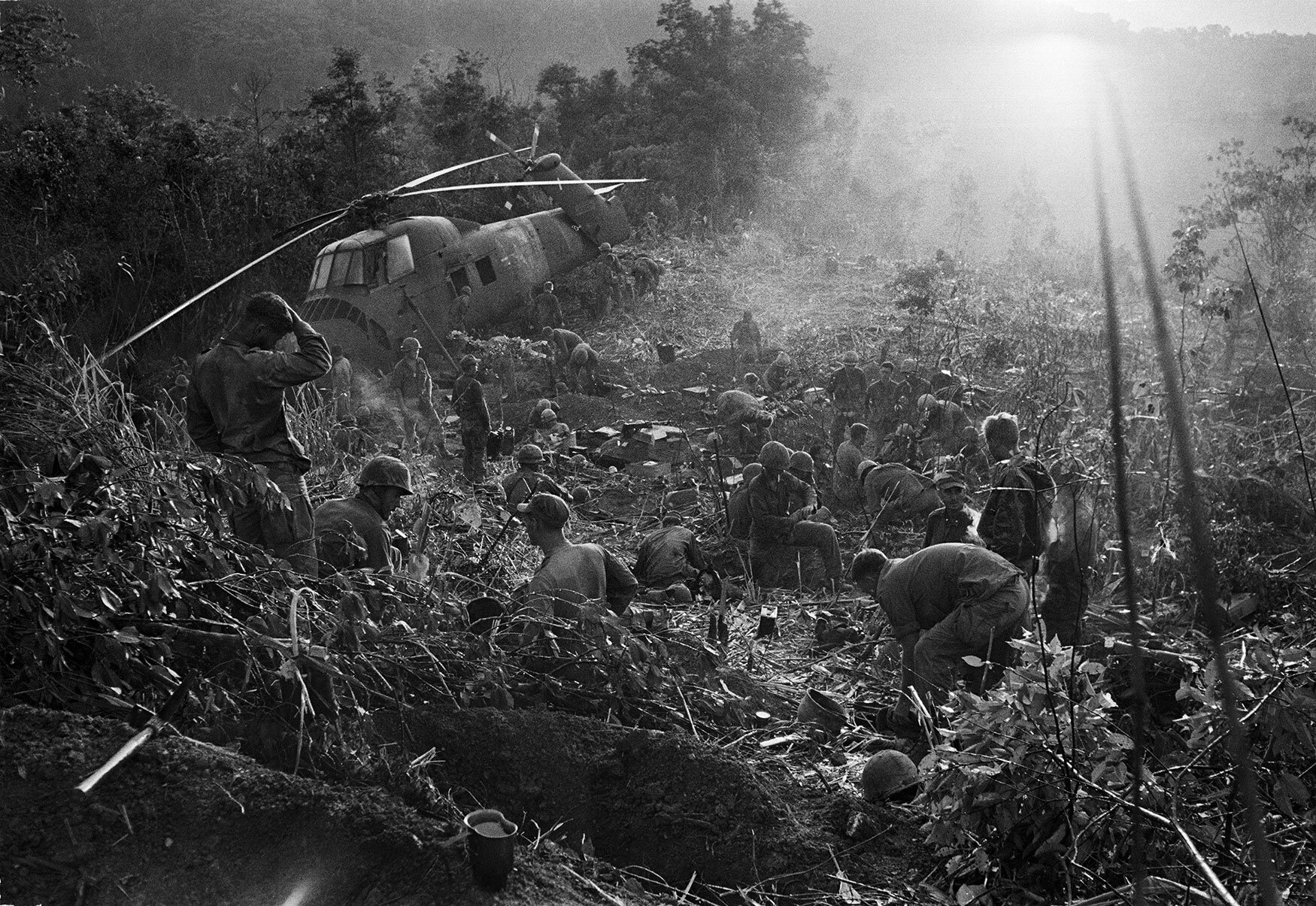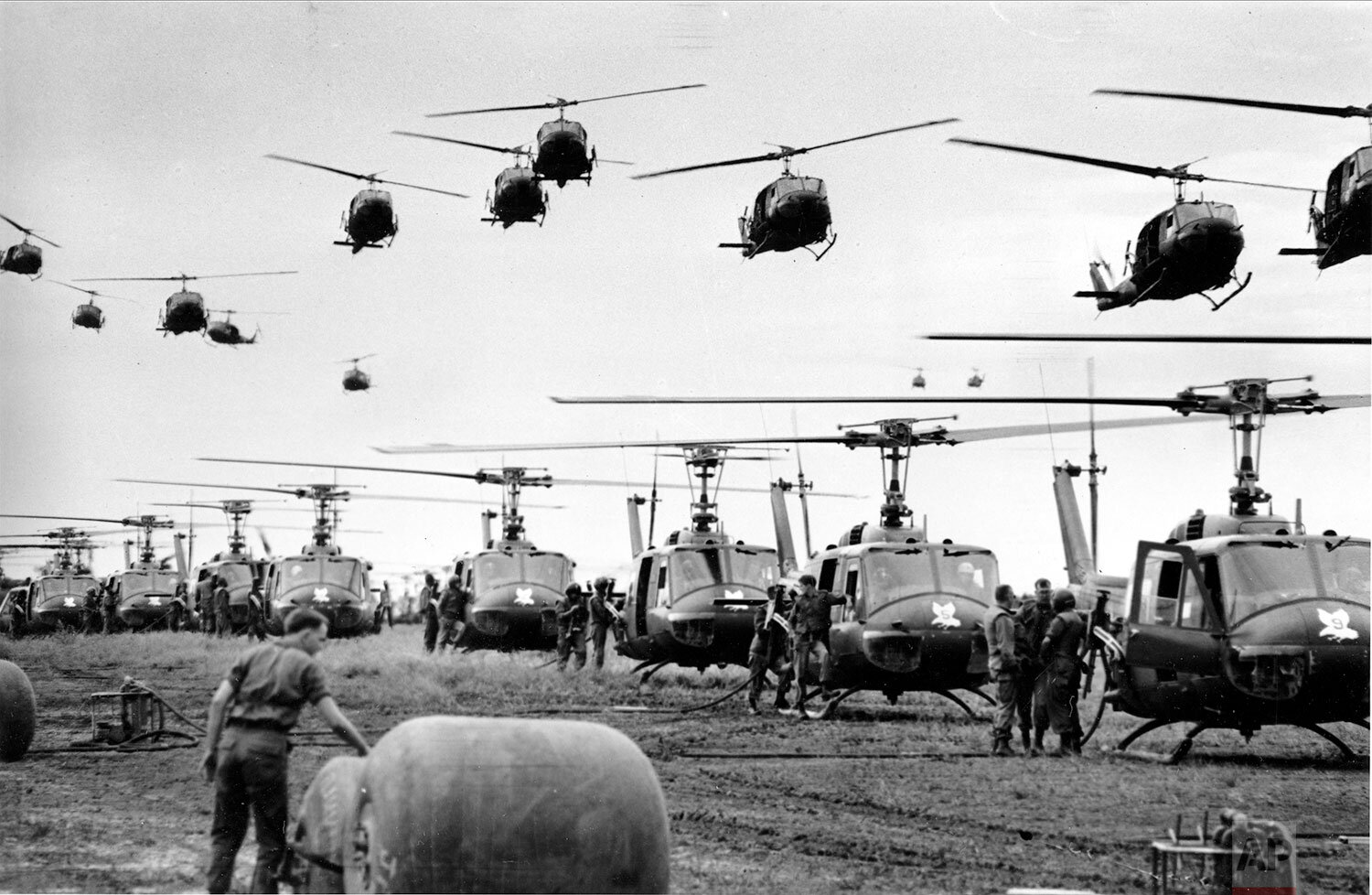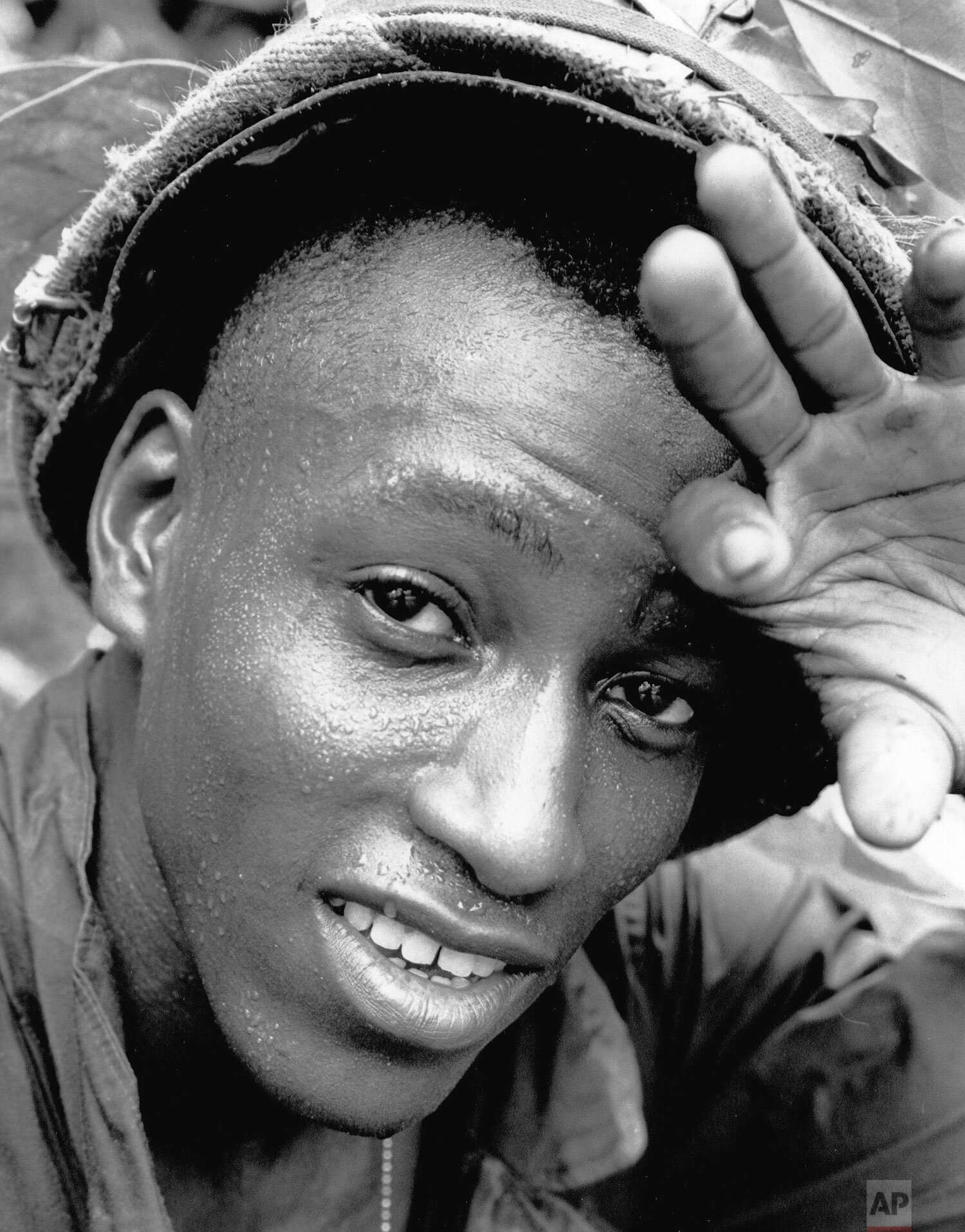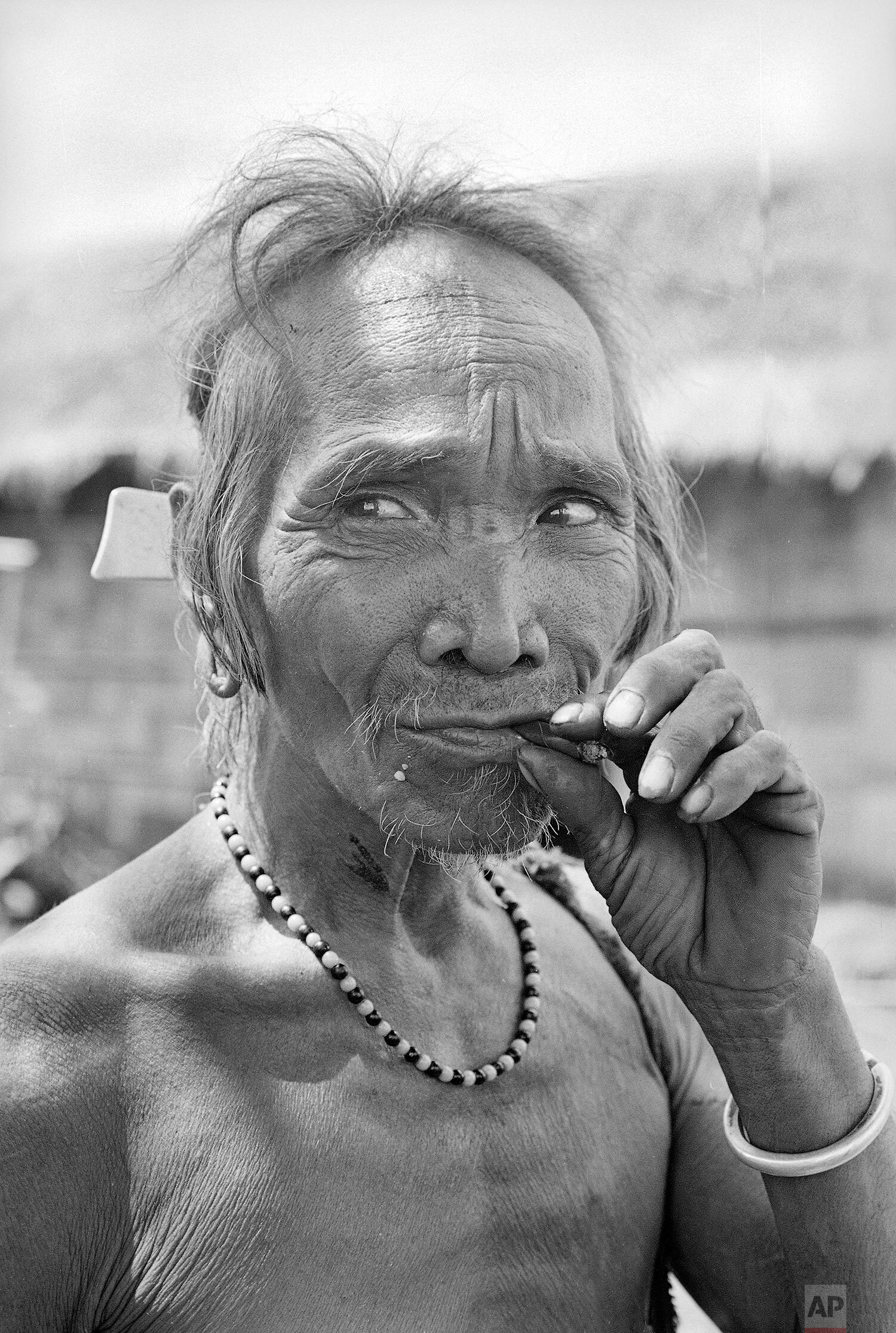Remembering Henri Gilles Huet, 1927-1971

“There was no finer man that ever lived.”
—Former Saigon Bureau Chief, Richard Pyle (1933-2017), recollecting AP photographer
Henri Huet in a 2006 oral history interview for the AP Corporate Archives
When Saigon bureau staff learned, on Feb. 10, 1971, that a helicopter had been shot down over the Ho Chi Minh trail and all aboard were feared dead, bureau chief Richard Pyle collapsed in disbelief.
“Henri,” Pyle recalled, “was in many ways the heart and soul of the AP’s Saigon bureau--the class act, the embodiment of what we all would wish to be like as war correspondents--he could not just be gone in a flash.”
But he was, at age 43. Also killed were three other well-respected combat photographers in their life’s prime: Larry Burrows of Life magazine, the senior member of the group, Kent Potter of UPI, and Keisaburo Shimamoto, a freelancer for Newsweek magazine.
Huet had been hired away from UPI by AP Saigon photo chief Horst Faas in 1965, a major coup for the AP photo operation. For Huet was already widely known as a gifted and courageous photographer. Having studied painting in Brittany, his father’s native land, he saw the beauty of war with an artist’s eye. But he saw the pity of war with his heart.
“[In his photographs], you will come as close to the experience of combat as is possible for anyone fortunate enough never to have seen a war,” declared writer Pete Hamill in his introduction to “Vietnam, The Real War: A Photographic History by The Associated Press,” published in 2013.
On the 50th anniversary of his death, we look again at the photographs of Henri Huet.
WARNING: THIS POST CONTAINS GRAPHIC CONTENT
The Pity of War
Chaplain John McNamara of Boston makes the sign of the cross as he administers last rites to photographer Dickey Chapelle, Nov. 4, 1965. Chapelle was covering a U.S. Marine unit on a search and destroy operation near Chu Lai for the National Observer when she was wounded, along with four Marines, by a mine accidentally tripped by a lieutenant in front of her. She died in a helicopter en route to a hospital. Chapelle was the first female American war correspondent to be killed in action. Photograph by Henri Huet.
Medic Thomas Cole of Richmond, Va., looks up with his one uncovered eye as he continues to treat a wounded Staff Sgt. Harrison Pell of Hazelton, Pa., during a firefight, Jan.30, 1966. The men belonged to the 1st Cavalry Division, which was engaged in a battle at An Thi in the Central Highlands against combined forces of the Viet Cong and North Vietnamese. This battle, and the extraordinary risks Huet took in making this and other photos as bullets whizzed past his head, came to define Huet for his colleagues as utterly indifferent to fear. When Life magazine’s Larry Burrows saw this image in the AP bureau, shortly after it was developed, he said, “That’s a Life cover.” It appeared on Feb. 11, 1966. Photograph by Henri Huet.
Soldiers of the 101st Airborne Division carry a wounded comrade through the jungle, May 1966. Photograph by Henri Huet.
The body of an American paratrooper killed in action in the jungle near the Cambodian border is lifted up to an evacuation helicopter in War Zone C in 1966. The zone, encompassing the city of Tay Ninh and the surrounding area north of Saigon, was near the Cambodian border and the site of the Viet Cong's headquarters in South Vietnam. Photograph by Henri Huet.
A soldier positions himself over his rifle as he protects a wounded comrade while they crouch before a log in thick mud during battle near Phuoc Vinh, June 15, 1967. Another soldier is visible behind the log. In 30 minutes of fighting, six men were killed and 12 wounded from B Company of the 1st Battalion, 16th Infantry, 1st Division. Photograph by Henri Huet.
Medic James E. Callahan of Pittsfield, Mass., gives mouth-to-mouth resuscitation to a dying soldier in war zone D, about 50 miles northeast of Saigon, June 17, 1967. Thirty-one men of the 1st Infantry Division were killed in the guerrilla ambush, with more than 100 wounded. Photograph by Henri Huet.
With sniper fire still passing overhead, medic James E. Callahan of Pittsfield, Mass., treats a U.S. infantryman who suffered a head wound when a Viet Cong bullet pierced his helmet, June 17, 1967. Thirty-one men of the 1st Infantry Division were reported killed in the three-hour guerrilla ambush about 50 miles northeast of Saigon, with more than 100 wounded. Photograph by Henri Huet.
Photographer Larry Burrows of Life magazine, far left, struggles through elephant grass and the rotorwash of an American evacuation helicopter as he helps GIs to carry a wounded buddy on a stretcher to the helicopter in Mimot, Cambodia, May 4, 1970. The evacuation took place during the incursion into Cambodia by U.S. and South Vietnamese forces. This image showcases Huet’s unerring sense of timing and composition. Photograph by Henri Huet.
The Beauty of War
Paratroopers of the 2nd Battalion, 173rd Airborne Brigade, hold their automatic weapons above water as they cross a river in the rain during a search for Viet Cong positions in the jungle area of Ben Cat, Sept. 25, 1965. The paratroopers had been combing the area for 12 days with no enemy contact. Photograph by Henri Huet.
JPG Army helicopters providing support for U.S. ground troops fly into a staging area 50 miles northeast of Saigon, January 1966. Photograph by Henri Huet.
South Vietnamese soldiers moves downriver in sampans during a dawn attack on a Viet Cong camp, Jan. 10, 1966. Several guerrillas were reported killed or wounded in the action 13 miles northeast of Can Tho in the flooded Mekong Delta. Photograph by Henri Huet.
U.S. Marines emerge from their foxholes south of the Demilitarized Zone after a third night of fighting against North Vietnamese troops, 1966. The helicopter at left was shot down when it came in to resupply the unit. Photograph by Henri Huet.
A U.S. 1st Cavalry reconnaissance unit overlooks the beach at Qui Nhon, on the central coast of South Vietnam, during Operation Thayer II, in late 1966. The operation, which began on October 25, was a follow-up to an earlier search-and-destroy mission whose goal was to uproot insurgent forces, as well as the Viet Cong's political infrastructure, from Binh Dinh Province. It concluded in February 1967 after heavy losses on both sides. Photograph by Henri Huet.
Armed landing craft carrying troops of the Mobile Riverine Force patrol a meandering tributary of the Mekong River in the southern part of South Vietnam, September 1968. When contact was made with the Viet Cong, the troops would be put ashore while the ships provided covering fire. Photograph By Henri Huet.
Soldiers of the U.S. 11th Armored Cavalry Regiment are silhouetted atop their tank by the glare of tracer bullets in Cambodia, July 6, 1970. In an exercise known as Mad Minute, the soldiers would spray the area around them with automatic weapons fire before they moved on, in case it was infiltrated by guerrilla patrols. Photograph by Henri Huet.
Black market brokers move through a herd of cattle in an open-air market outside Chau Doc in the western portion of the Mekong Delta, July 25, 1970. The cattle had been smuggled across the border from Cambodia. In the background, in front of a Buddhist Temple, a convoy of trucks moves toward Cambodia for a military operation. Photograph by Henri Huet.
Faces of War
Two captured Viet Cong guerrillas, blindfolded and hands tied behind their backs, are guarded by American G.I.'s of the 1st Cavalry Airmobile during the battle of An Thi on the central coast of South Vietnam, Jan. 29, 1966. Photograph by Henri Huet.
Paratrooper Sgt. James R. Cone of Clarksville, Tenn., holds a puppy that nipped him as he groped about in a cave entrance on a river bank in Lam Dong Province, July 24, 1966. At left is Pfc. George R. Rosen of Whitehall, Mont. Troops of the 173rd Airborne Brigade were searching for Viet Cong guerrillas in the caves, but the men had fled, leaving only women and children behind -- and one dog. Photograph by Henri Huet.
Pfc. Eugene Cabbagestalk of Pittsburgh pushes back his helmet to wipe sweat from his face, August 1966. Cabbagestalk, who had been in Vietnam only a month, was killed the following January at age 20. Photograph by Henri Huet.
A Montagnard man (“mountain dweller” in French) smokes in Bu Lach village, September 1968. Henri Huet grew up on a large plantation in Dalat where the indigenous Montagnard workforce tended the coffee plants, fruit orchards and grazing cattle and sheep. The lush farms of the Central Highlands supplied food for local villages as well as exports to lowland markets. Photograph by Henri Huet.
A Vietnamese mother and her children are framed by the legs of a soldier from the U.S. First Cavalry Division in Bong Son, Vietnam, Sept. 28, 1966. Photograph by Henri Huet.
A Vietnamese mother carries her children and her belongings in baskets as she is evacuated from Ben Suc, Jan. 17, 1967. In all, about 10,000 peasants were targeted for evacuation from the Iron Triangle as U.S. troops pushed through. Photograph by Henri Huet.
Members of a Montagnard settlement run to a U.S. helicopter in Bu Lach, seeking transport to a refugee camp, September 1968. Today, the Montagnard are known as “highlanders,” a reference to the Central Highlands of South Vietnam, where the French colonial government in 1950 had created the “pays Montagnard du Sud.” Photograph by Henri Huet.
Soldiers of the 9th Infantry Division relax on the long boat trip back to their base camp after a day trudging through the coconut groves of Kien Hoa province in the Mekong Delta, 1969. Photograph by Henri Huet.
South Vietnamese soldiers ride an armored vehicle along Route 9 into Laos at the start of Operation Lam Son 719, Feb. 8, 1971. The mission was aimed at disrupting North Vietnamese logistics along the Ho Chi Minh trail. This is one of the last pictures made by Huet, who was killed two days later.
Soldiers of the Americal Division ride on armored personnel carriers toward Lang Vel Special Forces camp, half a mile from the Laotian border, February 1971. The Americans -- barred by U.S. law from crossing the border themselves-- were clearing Route 9 to facilitate the South Vietnamese entry into Laos for Operation Lam Son 719. This photograph is from one of the last rolls of film shot by Henri Huet, who died February 10 along with three other photojournalists when their helicopter was shot down over Laos.
Friends in War
As he prepares to make a picture, Henri Huet is photographed by bureau chief, Richard Pyle near the Mekong Delta, 1970. The two met in August 1968, shortly after Pyle’s arrival in Saigon. Huet had just returned to Vietnam from New York where he had been treated for wounds to his lower right leg suffered on Sept. 22, 1967. AP Corporate Archives, Richard Pyle Photograph Collection.
When this picture was taken, probably just before Huet’s death, Richard Pyle (at rear on the telephone) was bureau chief. He recollected being able to see from the bureau chief’s office the framed portraits of AP photographers killed in the war, Oliver Noonan (whose portrait is visible), Huynh Thanh My and Bernard Kolenberg. AP Corporate Archives, Richard Pyle Photograph Collection.
“Someone had to write the story,” reflected Richard Pyle in his 2003 book, “Lost Over Laos: A True Story of Tragedy, Mystery, and Friendship,” and by unspoken agreement, a loss of life in our own circle required a bureau chief’s byline….I had never done anything like it before and have not since. It should have been difficult, writing through tears. But the words rolled out of my typewriter like any other breaking story.” The three sheets of wire copy, hand edited in pencil, are housed in the voluminous records of the Saigon Bureau, which were donated to AP in 2005 by former AP reporter Peter Arnett, who rescued the collection from sure destruction in 1972. AP Photo/AP Corporate Archives.
Former chief of AP Saigon photos Horst Faas (left) and former Saigon bureau chief Richard Pyle (right) pose on March 24, 1998 at the site of the helicopter shoot-down in the jungles of southern Laos 27 years earlier. The pair are accompanied by a U.S. MIA search team. The 2003 book, “Lost Over Laos: A True Story of Tragedy, Mystery and Friendship,” co-authored by Pyle and Faas, recounts their mission to find the remains of their friends. It is also an insightful short history of the press in Vietnam and of the sterling Saigon bureau in particular.
As he tells it, Pyle had come to believe that he could be reconciled to his friends’ fate “only if someone were to go to that place, walk on that mountain, taste the thick jungle heat. Someone to go there, address any spirits that might exist, and say to them, ‘I am here. We are here. We have come to tell you that you are remembered, and well.” The human remains found on that Laotian hillside were interred on April 4, 2008 at the Newseum in Washington, D.C. A small gold birth medallion, worn by Huet around his neck to remember his girlfriend, Cecile Blumental, was returned to her in Paris in 2011 at a retrospective exhibition of Huet’s photography. Photograph by Roger King.
Henri Huet, 1966. AP Photo.
Text by Valerie Komor, Director, AP Corporate Archives. With special thanks to Chuck Zoeller, editor of Vietnam: The Real War: A Photographic History (Abrams, 2013), who supplied the images for this posting.

































